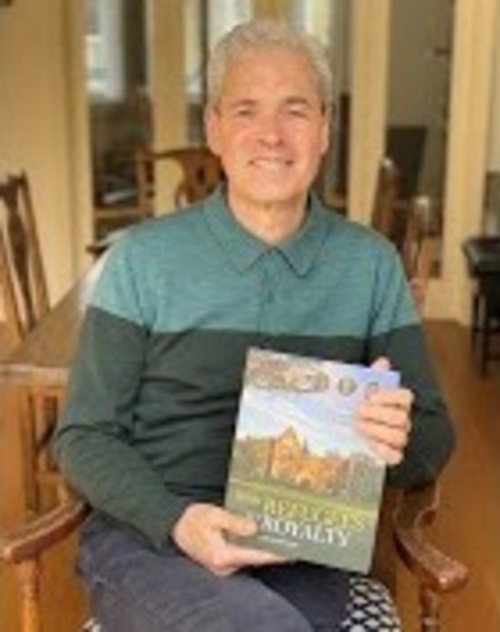LIVCOM LITERARY EVENING WITH PETER DAY AND JOHN HILARY - 13 OCTOBER 2021
25 OCTOBER 2021

Freeman Benedict Richards reports on this hour-long open event undertaken via Zoom and which focused on the remarkable story of the Messel family of Nymans in West Sussex.
Liveryman Mike James introduced this 15th Zoom event as the last in the current programme – a new programme will be announced in the new year. After a brief introduction with the book’s designer Freeman Benedict Richards, Liveryman Peter Day, as usual, was a consummate compere with his thorough research. The event comprised a fascinating conversation between the author, John Hilary, and Peter during which some of the main themes of the book were explored.
John has a background in writing trade reports and articles for newspapers but his book is closer to home because it tells the story of his family – from his great × five grandfather to more recent cousins. His story began with a holiday visit to a museum in the German village of Messel. This piqued his interest in his ancestors and what followed was a seven-year journey of research, interviews, and writing.
The story plots the trajectory of 18th-century Jews expelled from northern Germany, by an edict of George III, to their ultimate acceptance into British society. After their explusion, the family settled in Messel, southern Germany, from where they took their new name. At this time Jews were accepted in business but still excluded in other areas. So despite being relatively prosperous, life was still hard, and John’s great-great grandfather Ludwig Messel came to London joining the Jewish-American Seligman Bank. He worked his way up to head clerk and was followed to London by his brothers and a sister (who married the head of the bank!).
He later set up his own bank, L. Messel, which was still in business into the 1980s. The family prospered and Ludwig was at one time reputably the richest man in the stock exchange.
They lived in London in ‘Tyburnia’, a cosmopolitan area north of Hyde Park. But in 1890 Ludwig bought a relatively modest rural private retreat ‘Nymans’ for £20k. This purchase signified the putting down of roots in a way that was impossible back in Germany where Jews were forbidden to own property.
How did the family settle into the countryside? It wasn’t through hunting, shooting and fishing but through gardening. And rather than a formal landscaped garden, an attempt was made to cultivate newly imported plants from around the world in the Nymans’ micro-climate 500 feet above sea level. Leonard (Ludwig’s son) was fascinated by the garden but the head gardeners were perhaps the driving force behind the enterprise – one of them staying for 60 years. Ludwig’s daughter, Murial, even catalogued 4000 species in a published book.
In the 1920s there was a ten-year project to create a mock-medieval manor house using lots of materials from demolished manors elsewhere. But catastrophe struck in the winter of 1947 when a fire broke out and destroyed much of the house. Among the losses were a Velázquez, and a library of antique books.
Leonard died in 1963 and bequeathed the estate to the National Trust – their first garden – and it is now one of the most popular in the country – partly because of the magnificant seasonal changes, but also because of the attached story.
Other notable members of the family mentioned by John were: Ann Messel (the Countess of Ross) who was a founder of the Victorian Society; Oliver Messel, a theatre, opera, ballet, film and interior designer; Alfred, a well-known architect in pre-war Germany; and Rudolph, a socialist, film-maker, writer, critic, and who helped people escape Nazi Germany to Colombia. Tony Armstrong-Jones fits into the latter stages of the story. John remarked that Tony’s Jewish ancestry was not an issue for the press at the time of his engagement to Princess Margaret but what was of note to them was that he was a ‘commoner’. John was keen to emphasise than Tony was much more than the colourful character portrayed in the media, for instance, he was a prominent disability campaigner. Despite there now being many cousins, only one is named Messel, a silversmith who has clearly inherited the creative aspect of the family.
The great irony of the whole story is that 200 years after the family was banished from Germany by George III in the 1760s, Tony Armstrong-Jones married into that same royal family, and his son, Lord Linley, was born fifth in line to the throne. Ludwig would never have believed it!
There were several things John most enjoyed finding out about during the writing of the book: revelations about the family and the social milieu in which they were living; discovering more about Alfred Messel, the architect; and lastly finding out about the women of the family – sometimes unrepresented.
John concluded by saying that his family were welcomed and accepted into Britain and they repaid the welcome many times over with their numerous contributions to society.
The book would make a wonderful Christmas present and John has kindly agreed to sign copies of the book which is available for £25, a percentage of which will be donated to the Stationers’ Foundation. Email Mike (mjames@dundaleassociates.co.uk) to register your interest and for bank details.
If you missed the evening and would like to watch please click the image below.